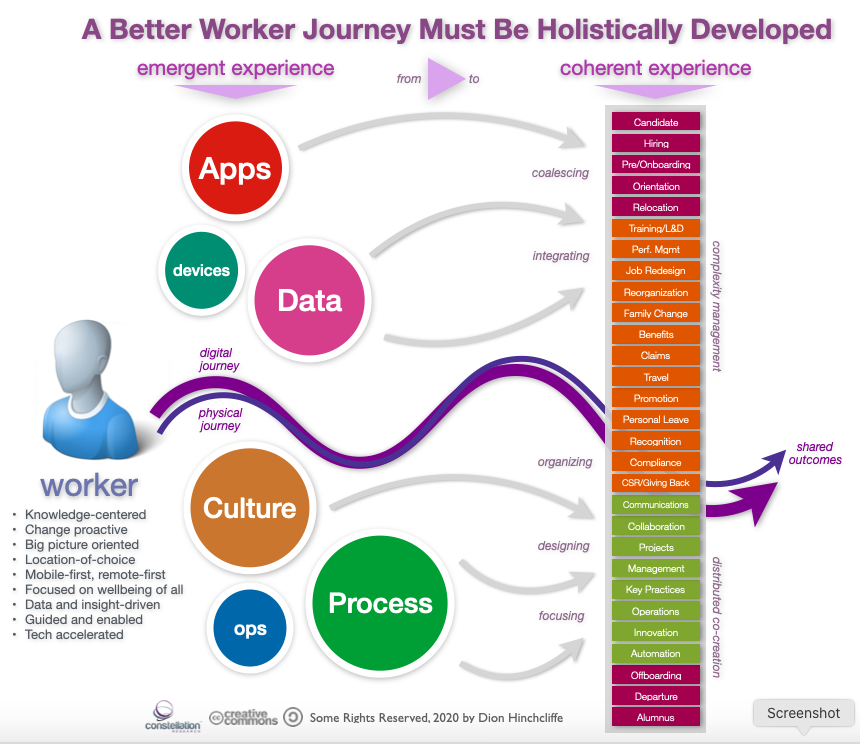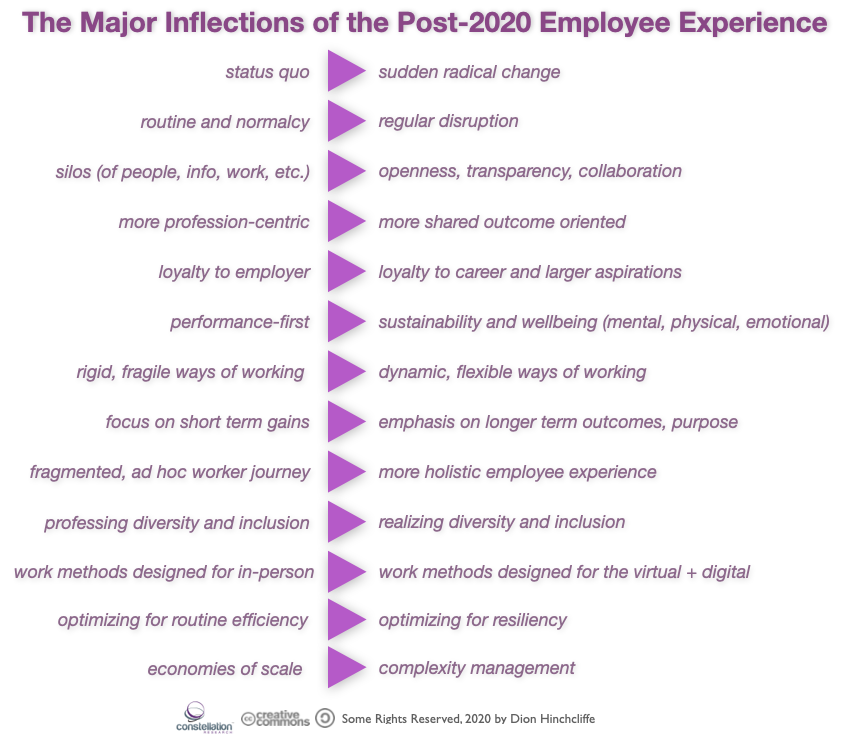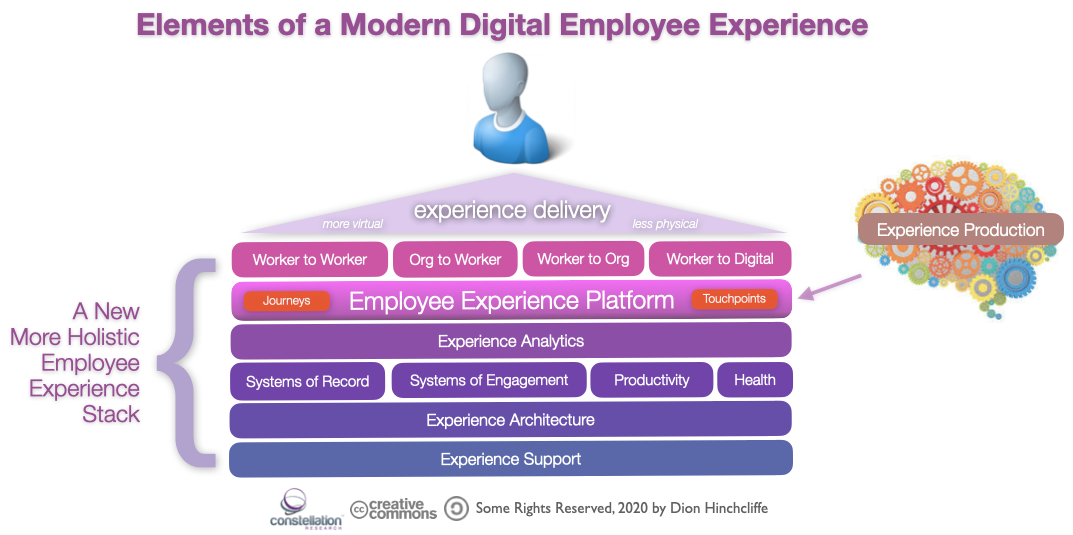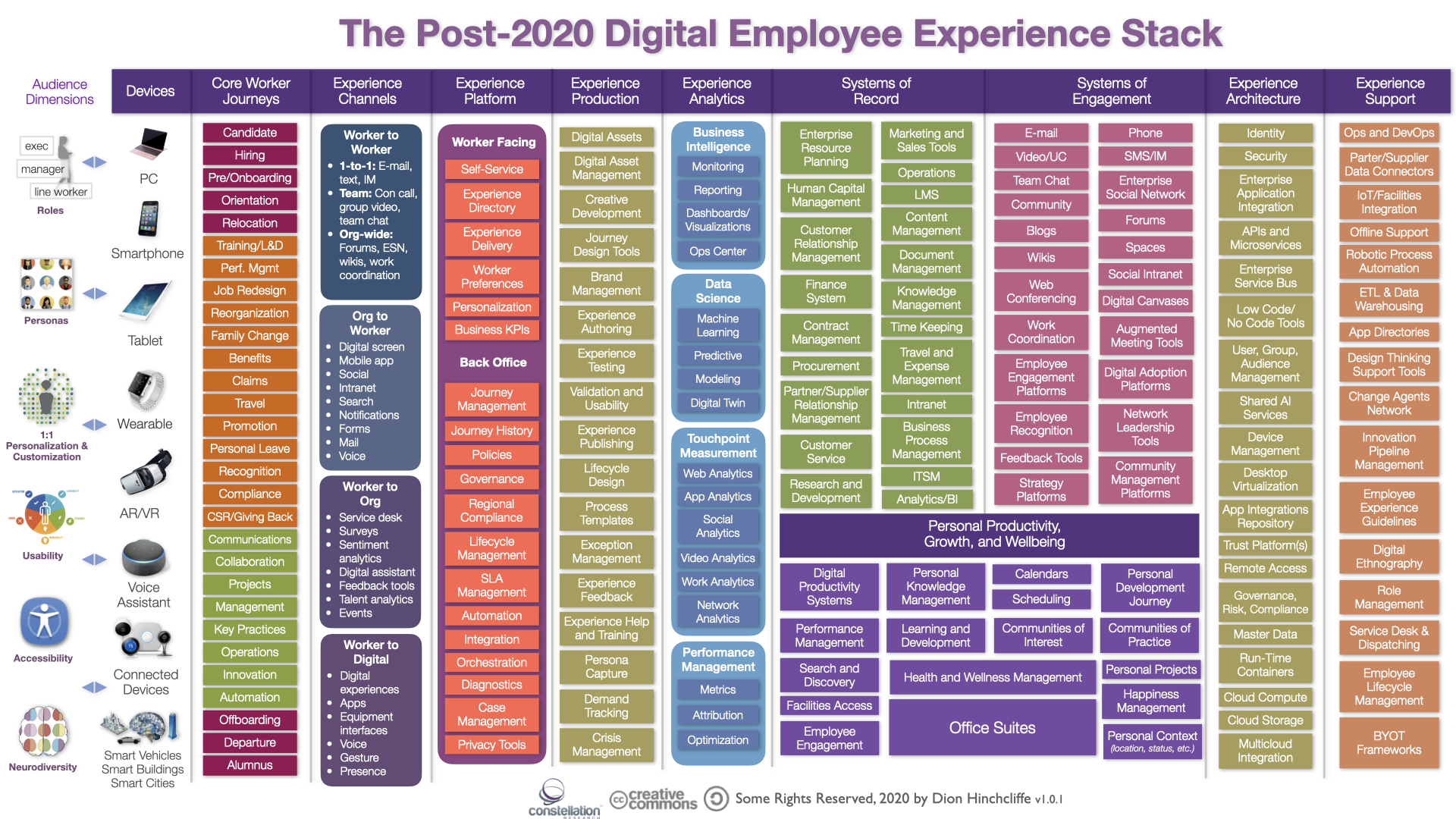We currently find ourselves living in rather suddenly altered times. The way we work has dramatically transformed, and all of us have now lived through some form major personal and professional disruption. Even what we must collectively prioritize in our work has shifted dramatically in many cases as well.
Organizations are also discovering themselves spending much of their energy managing the consequences of a global pandemic as well as emerging worldwide societal issues, all while coping with a very uncertain and impossible to ignore global economic outlook. As this takes place, our key institutions -- needed at their most in this moment -- seem to having trouble finding their footing in this era of high complexity, pervasive interconnectedness, and a combined sense of profound inequality/disparity.
As organizations today, if we're not threatened outright with survival then it's at least wholesale transformation by industry. We are still fully appreciating the dramatic recent dislocations and momentous shifts in our underlying assumptions about nearly everything we do to manage and operate our businesses. It's certainly very challenging to grapple with all of this, much less maintain a clear sense of trajectory and purpose.
However, within this sea change of events there is in fact a key dimension of our organizations that has perhaps been the most profoundly disturbed. It's also the most important element to reach whatever new operational model(s) we must move to. Unfortunately, this dimension is also one that has historically received comparatively little long-term strategic investment and has usually been mired in low prioritization, technical debt, and benign neglect.
Yes, I am referring to what is now referred to as the employee experience. For the uninitiated, this view considers both the broad and specific needs of the worker, then establishes a readily navigable physical and digital journey through which workers can engage and collaborate together with each other, key stakeholders, and the wider organization to meet shared goals and objectives. It's how the worker experiences how the business runs.
The Employee Experience Is "In Play" Like No Time In History
The employee experience, now that we understand it more fully, is the literal realization of the worker/organization compact. In short, it represents how we can transform combined human collaboration and technology assets into outcomes that matter to us all. How easy the experience is to use, how it sustains us as human beings, how effective it is to the business, how much it costs, the way it helps us uphold our highest beliefs, goals, and aspirations, and so much more are not only made possible by the nature of the employee experience, but are the essential dimensions of it.
But, as I've often ruefully noted over the years, when I put together a top ten list of yearly business priorities for almost any sized organization, the employee experience invariably falls right outside of it. Regardless of why this is -- and there are many reasons with 46% of employers saying they still have no stated strategy for it -- it's safe to say that those days, for the moment at least, are currently over. Overnight transformation of the employee experience has now happened, to create one that is now mostly virtual, more self-sufficient, self-service, and highly dynamic. What's more, it's likely to stay mostly that way says poll after poll. The largest shift ever in how we work arrived in just a few weeks, but the aftermath and ramifications will be felt for a half-decade or more.
As a result of all this, as we shall see, is that the employee experience after 2020 will be very different than the employee experience prior to 2020. The following is my best current analysis of what it will look like.
Insight #1: Employee experience is now a top priority of organizations for the first time in recent memory. But the full scope of the needed changes will require -- and mostly receive -- serious commitment to achieve.
Taking a look at the figure below, we can see a primary list of the major inflections that reached an active transition point this year, mostly due to the pandemic. Many were years in coming, but languished and did not achieve significant breakthrough until 2020.
As I found in many of my exploratory industry conversations which I conducted to help inform the views presented here, there's almost too much to take in, a hallmark of the sheer scope of the today's challenges. The dependencies, as we like to say in the technology world, are extensive, as many of these threads are connected together when it comes to the new shifts that will impact any new and/or updated employee experience.
Managing fast, forced change is perhaps a dominant theme of these major inflections, which has long been happening steadily in the realm of technology progress. But with events like COVID-19 and the recent large-scale civil protests on racial disparities, we see deep and profound change is not only looked to as important to address in a sustained fashion, it is seen as mandatory now.
The second theme is a shift in the employment contract, with workers not as tied to individual employers and their goals, but more involved in the bigger picture of their lives and the purpose their work brings to themselves and the world at large. That latter point is of outsized importance to Gen-Z, with 93% reporting it affects their choice of where to work. Thus there has been a growing push against the short-term thinking that the financial markets have over-emphasized for years. Now workers are now thinking about their careers, their greater social responsibilities, their desire to see positive change in the world, and seeking to have these aspects realized more effectively in their employee experience.
Other inflections are more a result of the fraught situation of the world today. These include a) an increasing emphasis on the wellbeing of workers, b) developing new models for work that are more resilient and less easy to disrupt when large changes happen, and c) delivering on work methods more suited to our future state, which is more distributed, more remote, and more virtual than it ever has been in the past. These include key digital work skills like network leadership.
Another overarching theme, which I've been forming as a critical underlying hypothesis, is a growing urgency to move away from industrial age economies of scale when it comes to managing employee experience, where one-sized-fits-all was sought. With today's technologies, we can now provide locally adapted experiences with a granularity approaching a 1:1 level of personalization, but nearly as inexpensively as a cookie cutter model. When mass customization is a cheap as same-for-everyone scale, you can meet individual needs far better with the same level of investment/effort. This does require what I call complexity management of a higher order, however. In fact, that very subject has now become a top IT issue, according to a just-completed CIO survey by Cisco. I'll explore how our ability to deal with this issue well is unlocking vast new possibilities in employee experience soon.
Automation and artificial intelligence (AI) are the keys to delivering this breakthrough and each have profound ramifications for employee experience. In particular, this means everyone's employee experience will eventually be both unique and optimized just and only for them. Understanding and realizing the power of this will take the next decade to fully unfold in the industry.
This leads into the last major type of inflection I'm seeing: A growing frustration with the poorly situated and outdated state of the tools that workers are given, both from managers, HR professionals, and the workers themselves (IT staff are the most pleased with what they've delivered for employee experience so far, but have some good reason not to be in my and others' estimation.) Today's employee experience is largely carried out ad hoc and on-the-fly by the worker themselves out of a vast grab bag of technologies, prior work products, data sets, and institutional knowledge. This employee experience landscape, which I dub a largely accidental one, isn't generally very elegant or effective.
A new generation of workers is also entering the workplace en masse, as I noted in my Future of Work predictions for 2020. Gen-Z isn't accepting what they find the data shows. They want the now-expected high quality digital onboarding, virtual reality training, virtual assistants, wellness tools, and real-time feedback/recognition. While before there was no organizational willingness to make the investments, now we're having to and we might as well get it right.
Insight #2: The most direct and efficient construct to address these urgent inflections in the worker journey is in the employee experience.
However, today the employee experience is spread across many physical, digital, and cultural touchpoints. While the big shift in 2020 has been to the digital, which arguably forms the majority share of the experience at this point for many of us, the usability trend in digital has actually been in the opposite direction for years. at least in the large: A growing blizzard of applications, channels, data streams, notifications, and other digital elements has created profound fragmentation that's only increasing. While all of these digital resources have value, our IT organizations and the industry as a whole has been ineffective at finding a solution to create better organization, design, structure, navigation, training, and adoption paths for all these technologies in the worker journey.
What's more, largely as a result of service gaps, users aren't waiting for IT to meet their technology needs and are sourcing technology solutions on their own. Shadow IT has now become an important part of the digital employee experience as well.
Nevertheless, a way to create what I refer to as a "center of gravity" or hub for employee experience is necessary to make it manageable. By this, I do not mean that employee experience should be centralized. It cannot be. It can be guided and influenced on high, and key personnel can create official experiences for their functions, but digital employee experience is now so vast that no centralized process could ever manage it. No, the future of employee experience is more distributed, with strong but tolerant coordination in the center.
This leaves us with the key question of where in the technology landscape the employee experience "lives." In this, there appears to be a need for a) a more consistent digital workspace that can help workers manage growing interaction complexity, b) an ability to quickly connect their data and apps better together to solve problems, and c) finding and accessing experiences that guide them in business processes that cross a growing number of tools (sales teams, marketing, customer service, project managers, all key roles, have seen an veritable explosion in the number of tools they must use to do their job in recent years.) This must be made simpler, and the employee experience should have best practice laden digital journeys that workers can readily locate and fire up to do their job.
What we apparently need then, for lack of a better term, is some form of employee experience platform. Platform is a popular term bandied about with reverence in technology circles -- and usually for good reason -- as a uniquely powerful way to organize and marshal concentrated resources around a problem space. Employee experience is front-and-center that problem space for businesses in spades today.
The problem space in employee experience is evident to most of us at the moment: Workers are far too siloed and isolated in their new remote digital outposts. They are working without in-person support and enablement that we've invested in for decades. The remote work digital employee experience we have now was never designed to be the primary employee experience and it suffers badly in many cases. The ever-growing digital employee experience we do have is far too hard to learn and use effectively. Finally, we don't have the digital literacy and leadership skills necessary to fully exploit the massive investment in technology that we have -- and must continue to make -- in order for all of this to work well. This list is not exhaustive. There are numerous other issues, but addressing these systematically first would go a long way.
Insight #3: Transforming employee experience will require a platform solution of the highest order, even if no single platform will likely ever deliver it.
In spending a great deal of time in the last few years analyzing and redesigning modern digital workplaces and employee experiences, several trends have become evident to me: Most apps and data need to integrate in some way to service business needs. And the more apps and data there are, the more true that is, which is why virtually every tech solution has gone out of its way to add app integrations. But they tend to be shallow, general purpose, and in my experience, used to a very limited degree except for one or two critical integrations. For those not tracking this trend, this means that urgently sought after integration needs still isn't being met by the market, by current supply, by a large margin.
Instead, workers become the glue in the systems, the manual laborer knitting it all together. They must make their digital tools and data work together by hand in their employee experience. This is a very poor way of meeting worker needs with technology. While it's still better than using no technology at all, there is enormous headroom for improvement. Yet until recently, it was too hard to build and maintain employee experiences that connected together a critical mass of key business systems and their data together to say, design a personalized end-to-end new hire onboarding process, or create a marketing campaign, run a project, build a team, or solve a supply chain issue, etc. This difficulty is no longer necessary and must be steadily addressed by more modern approaches to producing a more directed and organized employee experience.
Fortunately, we are now witnessing an explosion of solution categories that can indeed enable enterprises to more quickly craft and produce world-class employee experiences that better connect people, apps, and data into interactive, guideded, and highly collaborative scenarios. Many underlying technical trends, from microservices and low-code/no-code, to experience management systems, digital adoption tools, and others have come together to create an incredible palette for developing a next-generation employee experience. What's more, assuming the right IT foundation is in place -- and big if, because most large organizations have reams of technical debt -- employee experience can be treated as a literal entity that can be organized, structured, produced, orchestrated, measured, and governed. Just not centrally, for it's clear the employee experience will be created by everyone, albeit certain central functions a bit more offically, such as HR, IT, comms, legal, operations, supply chain, customer care, and so on.
Whether an organization finds a unifying platform that can bring order to employee experience at the right level of abstraction and usability, or brings the pieces together by cobbling together their own, we can now identify a clear gap in our employee experience portfolio, namely a platform that connects the rest of the organization together and allows digital and even physical resources to be marshalled into experiences in a rapid, malleable, and highly cost effective way. That the elements depicted above and below are necessary in a more efficient and higher production rate form, I am highly confident. In fact, this is actually an internal version of my experience integration stack view, another urgent industry-wide situation in that prior to recently, personalized digital experiences were far too hard to create at scale out of the raw technology and data that we had. Due to the trends I just enumerated, this is being ever-more solved for customers. Now we are having to -- and finally able to -- solve it for employees too.
The upshot: Focusing on delivering great employee experience via better integration, design, production, and management is about to become a major top-level -- as well as locally distributed -- activity in most organizations in the next few years.
Insight #4: Employee experience is all-compassing, but to deliver on it successfully it must consistently result in simpler, easier worker journeys than before.
Its scope must be vast, but the result must be to streamline, remove friction, and accelerate work in a more sustainable fashion that meets shared longer term goals. Divide and conquer must be the approach.
In analyzing the trends going into 2020, and seeing how a step change in employee experience was required in remote work, and how most organizations were only able to do the bare minimum, and it's clear that we have so much more work to do. And returning to work is now the next discussion. What kind of employee experience should our workers return to? This will require some of the most sophisticated and far-reaching thinking most of us have ever done in our careers.
To aid in this, I've spent the last few weeks assembling a vast visual of most of the key moving parts of this more holistic model of employee experience, so we can see the full fabric upon it must be wrought. Some have commented how complex this view is, and I concur. A major point in assembling such a view is to discourage IT, HR, or any single function from imposing a single type of view on it or owning employee experience altogether. It's far too broad, deep,and nuanced for that ever to be possible. Certainly experience production (meaning the creation of experience-led scenarios supported by existing apps, data, and team/communities) for certain official functions would belong to the groups responsible for them, though even these might be extended by local groups who want or need say, a special onboarding or project management process for a valid reason.
Ultimately, achieving the necessary variety, customization, personalization, diversity, and local variability in employee experience requires the explicit encouragement of decentralized activity across the organization in the support and management of employee experience. In other words, we're all in employee experience now. This means an inclusive approach is in my view the only possible approach to meeting the scale and distributed nature of the challenge.
How Will You Meet the New Employee Experience Imperative?
There is so much to examine, explore, and explain in this rapidly emerging model of the employee experience stack. To help facilitate this industry conversation, I'll be breaking these views down into sections and going through them in more detail soon. In meantime, a big thanks to my employee experience industry advisory board for giving me early (and almost exclusively positive) feedback on this model.
I also welcome your own comments and observations online and via e-mail in order to make this approach to employee experience as useful, accessible, and actionable as possible.
Credit for advisory board contributions to the detailed stack view of employee experience above goes to: James Dellow, Rachel Happe, Jane McConnell, Andrew Nebus, Mariano Suarez-Battan, Neil Morgan, and Chee Chin Liew.
Additional Reading
It's Time to Think About the Post-2020 Employee Experience
How Work Will Evolve in a Digital Post-Pandemic Society
Revisiting How to Cultivate Connected Organizations in an Age of Coronavirus
My 2020 Predictions for the Future of Work
Working in a coronavirus world: Strategies and tools for staying productive | ZDNet
A Checklist for a Modern Core Digital Workplace and/or Intranet
Creating the Modern Digital Workplace and Employee Experience
The Challenging State of Employee Experience and Digital Workplace Today






